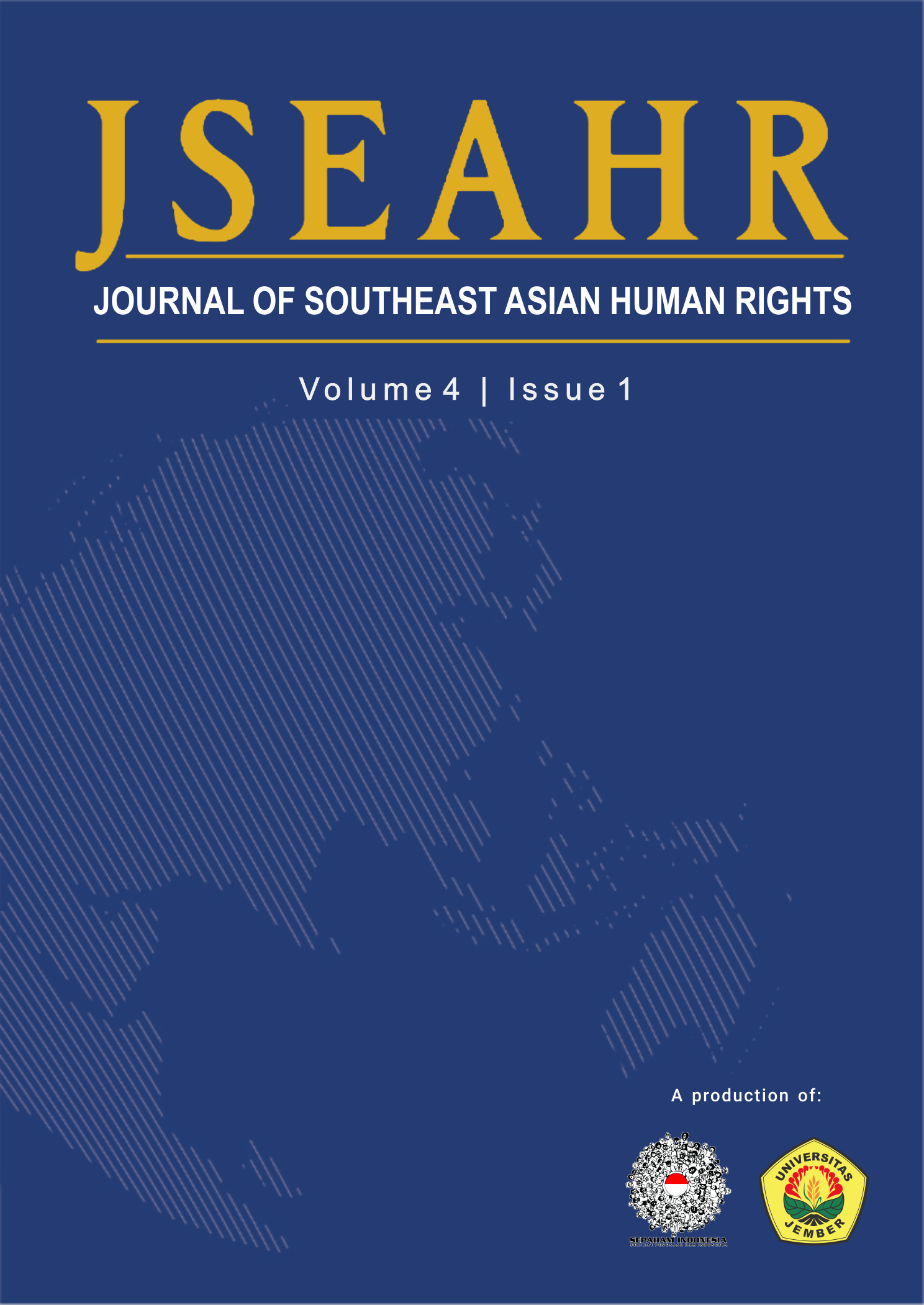Myanmar: the country that ‘has it all’
DOI:
https://doi.org/10.19184/jseahr.v4i1.17922Abstract
For scholars of Southeast Asia interested in human rights, Myanmar is a country that ‘has it all.’ I use this tongue-in-cheek expression to suggest the myriad ways that the country remains mired in structural challenges that inform its current human rights problems. In this paper, I point out the country’s most glaring structural challenges and link these to its most pressing human rights problems. A brief section about Myanmar in the context of COVID-19 offers the same conclusion as the rest of the article: while there is variance in the actors targeted and the degree of suppression, the underlying patterns of oppression remain unchanged over time.
Downloads
References
Beban, A., S. So and K. Un (2017). "From force to legitimation: Rethinking land grabs in Cambodia." Development and Change 48(3): 590-612.
Brenner, D. (2019). Rebel politics: a political sociology of armed struggle in Myanmar's borderlands, Southeast Asia Program Publications.
Callahan, M. P. (2005). Making Enemies: War and State Building in Burma. Ithaca, Cornell University Press.
CHRO (2012). “Threats to Our Existenceâ€: Persecution of Ethnic Chin Christians in Burma. Nepean, Canada, Chin Human Rights Organisation.
Crouch, M. (2020). "Pre-emptive Constitution-making." Law & Society Review 54(2).
Farrelly, N. and C. Win (2016). "Inside Myanmar's Turbulent Transformation." Asia & the Pacific Policy Studies 3(1): 38-47.
Fortify Rights (2018). “They Gave Them Long Swordsâ€: Preparations for Genocide and Crimes Against Humanity Against Rohingya Muslims in Rakhine State, Myanmar. Bangkok, Fortify Rights.
Gabusi, G. (2018). Change and Continuity: Capacity, Coordination and Natural Resources in Myanmar's Periphery. Myanmar Transformed?: People, Places and Politics. C. Win, G. McCarthy, J. Chambers and N. Farrelly, ISEAS–Yusof Ishak Institute: 137-160.
Kyaw, N. N. (2020). "MYANMAR IN 2019: Rakhine Issue, Constitutional Reform and Election Fever." Southeast Asian Affairs: 235-254.
Lang, H. (2002). Fear and Sanctuary: Burmese Refugees in Thailand. Ithaca, NY, Southeast Asia Program, Cornell University.
Lintner, B. (1999). Burma in Revolt: Opium and Insurgency since 1948. Chiang Mai, Silkworm Books.
MacLean, K. (2019). "The Rohingya Crisis and the Practices of Erasure." Journal of Genocide Research 21(1): 83-95.
Myint-U, T. (2020). The Hidden History of Burma: Race, Capitalism, and the Crisis of Democracy in the 21st Century, Atlantic Books.
Oak, Y. N. and L. Brooten (2019). The Tea Shop Meets the 8 O'clock News: Facebook, Convergence and Online Public Spaces. Myanmar Media in Transition: Legacies, Challenges and Change. L. Brooten, J. M. McElhone and G. Venkiteswaran. Singapore, ISEAS: 325-365.
Sadan, M. and R. Anderson (2016). Historical Perspectives on War and Peace in Kachin Space: The First Kachin Ceasefire 1944-1961. War and Peace in the Borderlands of Myanmar: The Kachin Ceasefire, 1994-2011. M. Sadan. Copenhagen, NIAS Press: 29-54.
Selth, A. (1986). "Race and Resistance in Burma, 1942-1945." Modern Asian Studies 20(3): 483-507.
Smith, M. (1999). Burma: Insurgency and the Politics of Ethnicity. London, Zed Books.
UN (2020). Covid-19 and Human Rights: we are all in this together, United Nations: 1-22.
Woods, K. (2011). "Ceasefire capitalism: military–private partnerships, resource concessions and military–state building in the Burma–China borderlands." The Journal of Peasant Studies 38(4): 747-770.







